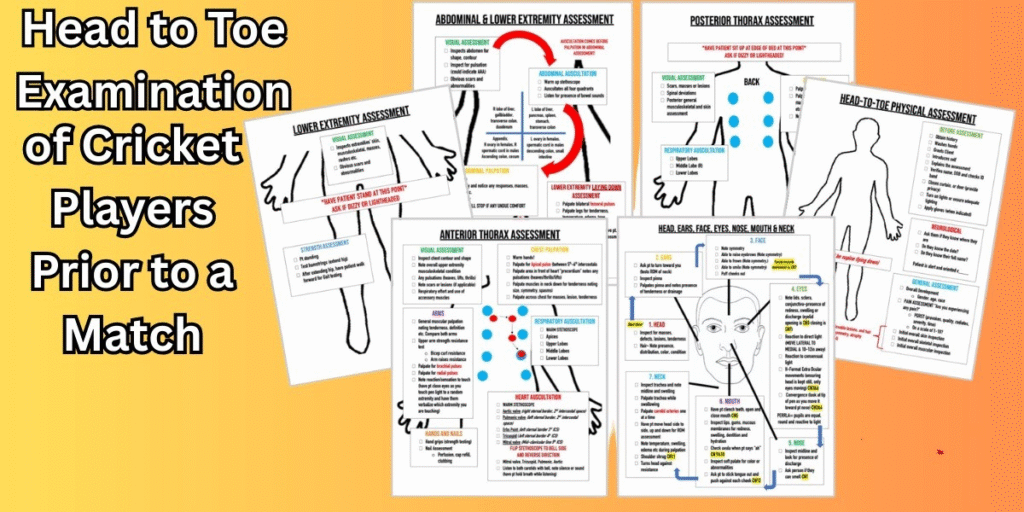Cricket requires both mental and physical fitness. Players prepare carefully before every game. Head to toe examination is an important component of the preparation. It helps to ensure players are ready physically for the match, avoid injuries and remain at their peak performance. This blog will explain what the examination entails, head-to-toe.
Why Head to Toe Examination is important
It is important to have a complete checkup from head to foot. Cricket players can benefit from this procedure in many ways:
- Prevent injuries: The sport of cricket involves sudden movements, running, throwing and bowling. Physical checks can help identify any injuries or weaknesses.
- Overall Test: Players require endurance, strength and agility. The overall level of fitness is assessed by a full-body exam.
- Mental Ready: Health affects focus. Players who are in good physical condition can focus better.
- Customized Training Coaches or trainers may plan training exercises according to the results of an examination.
Let’s see what occurs during the examination.
1. Head and Neck Exam
Start with the neck and head. They are crucial for safety and coordination.
- Eyes: Visual acuity is essential in cricket. To catch the ball and to judge distances, players need good vision. The trainers will check your vision, and if necessary suggest lenses.
- Hearing: It is essential for communicating on the pitch. The ear health of players is tested to make sure there are no balance or infection problems.
- Mouth and Teeth: Check dental health. Healthy teeth are important because players may wear mouthguards while playing.
- Neck : Flexibility and strength of the neck are measured. If your neck is stiff or weak, you are more likely to get injured while playing, batting or bowling.
2. Examining the Shoulder and Arm
The arm and shoulder follow. They are essential for throwing, batting and bowling.
- Range Of Motion: The trainers measure how far the players can rotate or lift their arms. Injury can be caused by a limited range of motion.
- Strength Test: To test the arm’s strength, players can do light push-ups and resistance training.
- Injury check: Injuries like elbow or shoulder pain are evaluated to prevent them from worsening during the game.
3. Assessing the Heart and Chest
Cricket requires endurance and cardiovascular fitness.
- Blood pressure and Heart Rate: The heart rate of the players is measured at rest, and also after light exercise.
- Lung capacity and Breathing. Good lung function will be required for long running sessions and fielding. Simple breathing exercises can be performed by trainers to test this.
- Chest Muscles Strength and flexibility of chest muscles helps in bowling, throwing and powerful.
4. Examining the Abdomen and Core
In cricket, a strong core plays a vital role. This stabilizes your body and helps prevent back injuries.
- Core strength Test: Perform sit-ups and planks for abdominal muscle testing.
- Lower Back Exam: Check for any pain or stiffness in the lower back. This is important because bowling places pressure on your back.
- Digestive Health: Stomach issues can impact energy levels. The trainers make sure that players do not have any stomach problems, such as bloating or cramps.
5. Examining the Hips and Pelvis
The pelvis and hip play a vital role in movement and balance.
- Hip Flexibility Test : The players stretch their hips to measure flexibility. A tight hip can restrict movement and cause injury.
- Strength test Squats and lunges are used to measure hips and thighs.
- Injury Evaluation: Prior injuries such as groin sprains are checked carefully.
6. Leg Examination
The legs are the basis of any cricketer. Strong legs are essential for running, jumping, throwing, and fielding.
- A knee check is a simple examination of the knees to determine if there are any signs of pain, swelling or weakness. This is important because fast bowlers are prone to knee problems.
- Foot and Ankle Health Sprains or weak ankles may limit performance. Trainers test flexibility and stability.
- Muscle Power: The quadriceps and hamstrings are both tested.
7. Hands and fingers
In cricket, fingers and hands can be used for catching and batting.
- Test of Grip Strength: This test measures the grip strength with which players can hold a bat or a ball.
- Flexibility : The fingers and wrists should be able to move without restriction. It is essential for spin bowling, catching and other sports.
- Injury check: Past fractures and finger injuries will be checked in order to avoid a recurrence.
8. Skin and General Health
The sun is a constant companion for cricket players. The skin and overall health of the players is also examined.
- Skin Health : Check for sunburns, infections, and cuts. The trainer may suggest sunscreen or protective equipment.
- Dehydration Levels Can Reduce Performance. Dehydration is detected in players and they are advised to consume fluids.
- Nutrition status A healthy diet is essential. The players can get nutrition advice, including supplements and energy consumption.
9. Mental and psychological assessment
As much as it is a physical game, cricket is also a mind-game.
- Concentration and Focus: The player can do simple exercises for testing attention span.
- Anxiety and Stress Levels Trainers will check to see if the players feel anxious or stressed. Stress can negatively affect performance.
- Confidence and Motivation: A positive mindset is essential for players who are under pressure to bat or throw in stressful situations.
10. Final Fitness Summary
Trainers create a Fitness Report after the player’s head-to toe exam. The report contains:
- Strengths and weaknesses
- Injury risks
- Training or physiotherapy recommendations
- Diet, Hydration and Recovery Advice
It is important that all players are prepared to perform their best and play in a safe environment.
Summary
An complete Head to Toe Examination is more than just a check for injury. This is an approach that ensures overall mental and physical fitness. Every part of the human body, from the neck and head to the feet, is examined. It helps them avoid injury, keep their stamina up, and perform at their best on the pitch. These assessments are used by coaches and trainers to monitor and plan player training and health, as well as provide treatments.
Cricket preparation is just as important off-field as on. Head-to-toe checks help players to stay confident and focused, ready for every match. Understanding the importance of these examinations is important for both professional and amateur cricketers.
Read Also
- Pakistan National Cricket Team vs India National Cricket Team Timeline
- India national cricket team vs England cricket team timeline
- Gujarat Titans vs Mumbai Indians Timeline (2022-2025)
- RCB vs DC Head to Head in IPL, Records, Stats & Results
- Bangladesh National Cricket Team vs India National Cricket Team Timeline
- Namibia National Cricket Team vs England Cricket Team Timeline
- RCB vs MI Head to Head: Royal Challengers Bengaluru vs Mumbai Indians Timeline
- India National Cricket Team Vs South Africa National Cricket Team Timeline



